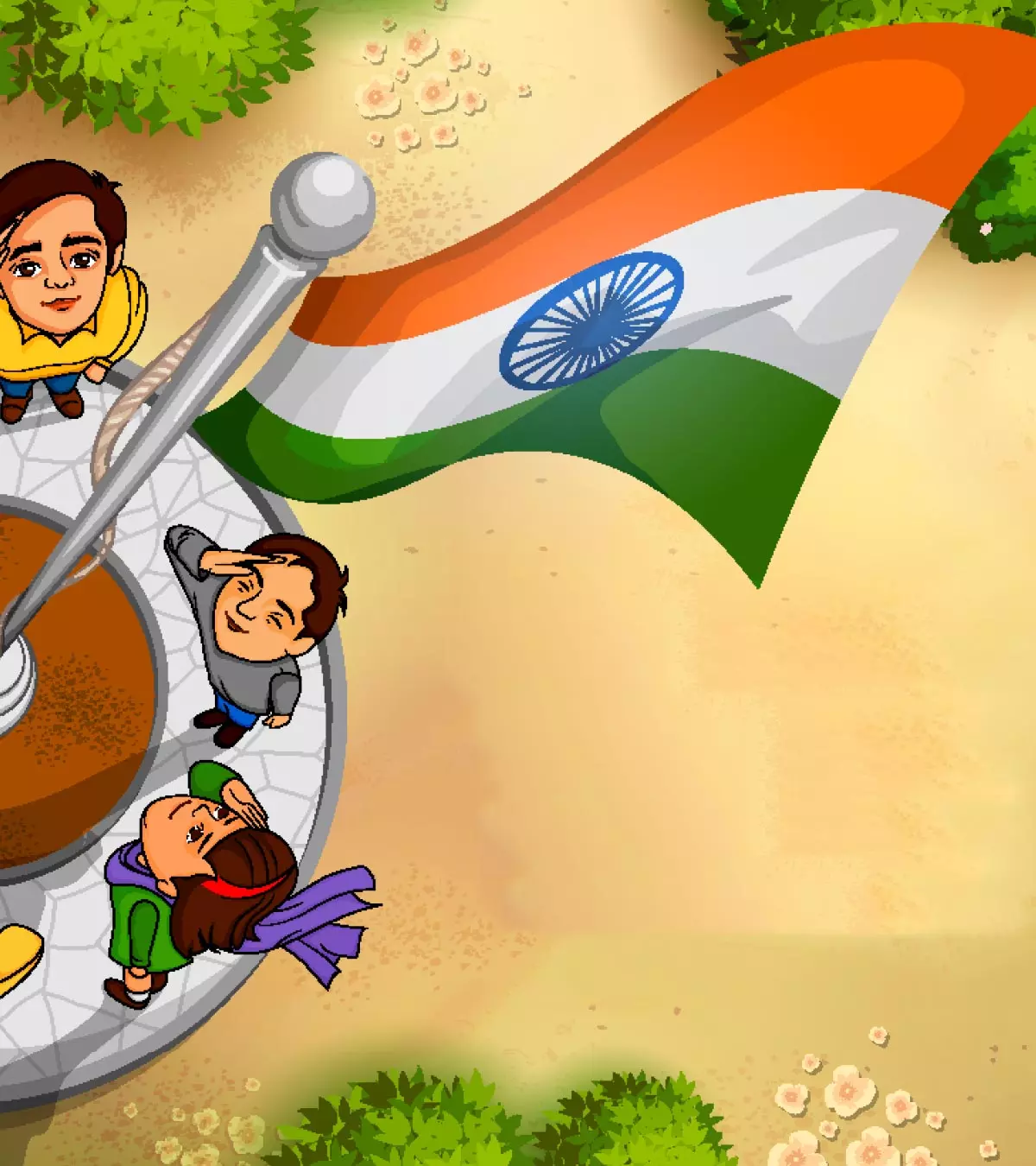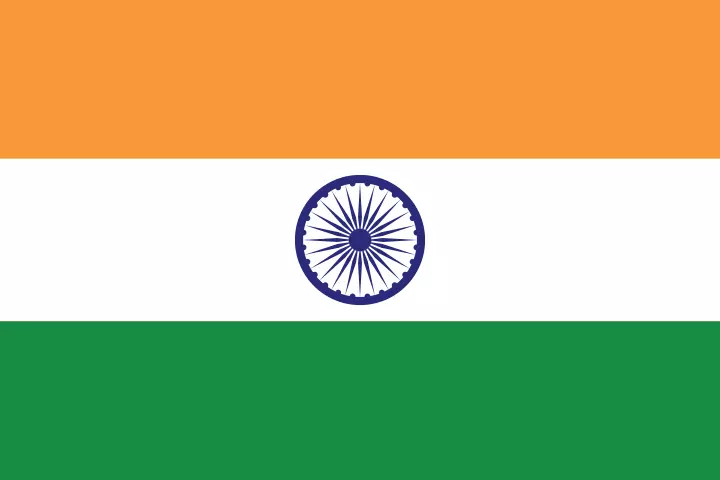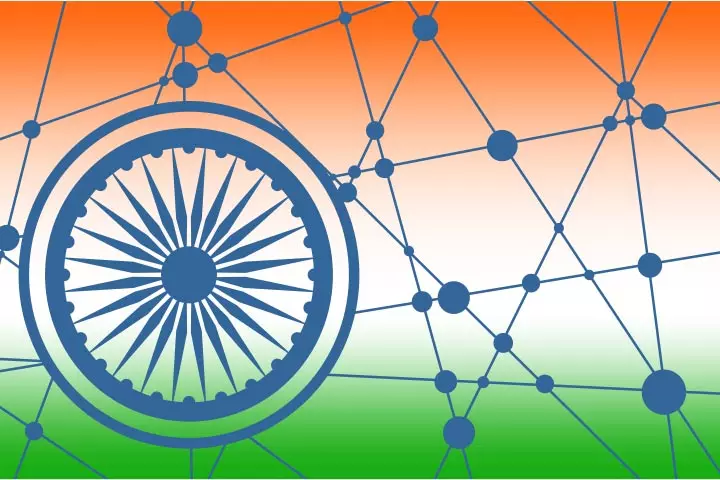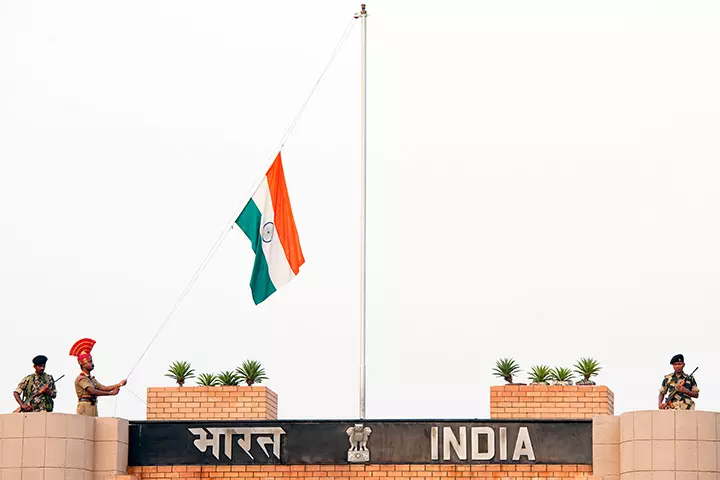
Image: Shutterstock
The national flag symbolizes an independent state of a country. One such country is India. Most children are keen to learn more about national flags; you may expand their curiosity by sharing some interesting Indian National Flag facts for kids that may help educate them and encourage them to know more about the flag. Each country’s National flag has a unique symbol, shape, and colors that differentiate it from others. Some intriguing facts on the Indian national flags may amaze you. Read this post as we discuss crucial facts about the Indian flag, such as when and by who it was created.
History Of Indian National Flag
The Indian National Flag was adopted in its present form on July 22, 1947, during the meeting of the Constituent Assembly. By then, the design and colors of the national flag were changed five times.
Evolution Of The Indian National Flag
The first Indian National Flag was hoisted on August 7, 1906.
It consisted of three horizontal stripes of green, yellow and red. The green stripe had eight white lotuses, the yellow section had Vandemataram written in the center, and the red stripe had a sun and a moon. It was hoisted in the Parsee Bagan Square of Kolkata.
Very similar to the first flag, the second flag had strips of orange, yellow and green. The topmost strip was orange and had seven stars that represented the Saptarishi. It was hoisted in Paris by Madame Cama in 1907.
Image: knowindia.gov.in
Dr. Annie Besant and Lokmanya Tilak hoisted the third version of the flag in 1917, during the Home Rule movement. This flag had four green and five red horizontal stripes, alternately. It also had seven stars in the Saptarishi configuration. On the top-left corner was the British flag or the Union Jack, and on the top-right corner was a white crescent moon with a star on the top.
In 1921, a new flag was unofficially adopted during the All India Congress Committee session that took place in Bezwada (present-day Vijayawada). It had two colors: red and green, which represented the two major communities in India: the Hindus and Muslims. Mahatma Gandhi suggested the addition of a white stripe to the design, which would represent the remaining communities of India. Also, a spinning wheel or ‘charkha’ was added on the white strip to symbolize the progress of the nation.
Image: knowindia.gov.in
In 1931, a resolution was passed to adopt the tricolor as our National Flag, which was also the battle ensign of the Indian National Army. The flag had a stripe each of saffron, white and green, with Mahatma Gandhi’s spinning wheel at the center. Also, the designers clarified that the colors of the national flag had no communal significance.
The present tricolor of India was adopted in 1947 by the Constituent Assembly. After India became independent, the colors of the 1931 Flag and the significance of them remained the same. But the spinning wheel was replaced by an emblem on the flag, the Dharma Chakra of Emperor Asoka.
Image: knowindia.gov.in
Keep reading for more interesting facts about the Indian tricolor.
31 Facts About Indian National Flag
1. The designer of the Indian National Flag
Image: wikimedia.org
The Indian National Flag was designed by Pingali Venkayya, who was a part of India’s freedom movement. He was born on August 2, 1876, in a small village near Machilipatnam in Andhra Pradesh. He was an expert in geology and agriculture, and also established an educational institution in his hometown.
2. Proportions of the Flag
India’s National Flag is a horizontal tricolor, with a width-to-length ratio of 2:3. It has three colors in equal proportions: deep saffron at the top, white in the middle, and dark green at the bottom. It also contains a navy blue wheel in the white section of the flag.
3. The significance of the Tricolor
The saffron color in the flag signifies strength and courage, white symbolizes peace and truth, and green means growth, auspiciousness, and fertility of the Indian land.
4. Emblem of the Flag
The wheel, which is also called the ‘Chakra’, has 24 spokes. It depicts the “wheel of the law” as reflected in the Sarnath Lion Capital ruled by the 3rd-century BC Mauryan Emperor Asoka. The ’chakra’ intends to show that there is life in movement and death in stagnation.
5. Sister Nivedita’s Flag
Irish disciple of Swami Vivekananda, Sister Nivedita designed the first ever Flag of India in 1904. It was composed of red and yellow colors, with Bonde Matoram written in the center. The flag also had a white lotus and a weapon of Lord Indra.
6. Gandhi’s Flag
Mahatma Gandhi mentioned about India having her own national flag in his journal Young India, in April 1921. He proposed a flag with the charkha at the center.
7. The Swaraj Flag
The British Government imposed a ban on displaying an Indian Flag. This led to the freedom fighters using a Swaraj Flag as a sign of protest. It was a tricolor with the charkha or spinning wheel in the center.
8. Indian Flag Code
The Flag Code of India was introduced on January 26, 2002. It is a set of practices, laws, and conventions which govern the display of the Indian National Flag. The Flag Code is divided into three parts: the first part consists of the description of the Flag, second part mentions the codes of display for public, private, and educational organizations and the third part of the code refers to the display of the flag by the central and state governments and their agencies.
9. The fabric of the Indian National Flag
The National Flag of India must be made of hand spun and woven wool, cotton, or silk and khadi bunting. It is important to note that hoisting a flag made of any other material is punishable and could lead to imprisonment of up to three years along with a penalty.
10. The flag-making process
The process of making the Indian National Flag involves six steps:
- Hand spinning
- Hand weaving
- Bleaching and dyeing
- Chakra painting
- Stitching
- Toggling
11. Dimensions of the Flag
Nine Standard dimensions of the Indian National Flag were specified by law. They are:
| Flag size no. | Dimensions (in mm) | Size of the Asoka Chakra (in mm) |
|---|---|---|
| 1 | 6300×4200 | 1295 |
| 2 | 3600×2400 | 740 |
| 3 | 2700×1800 | 555 |
| 4 | 1800×1200 | 370 |
| 5 | 1350×900 | 280 |
| 6 | 900×600 | 185 |
| 7 | 450×300 | 90 |
| 8 | 225×150 | 40 |
| 9 | 150×100 | 25 |
12. Protocols of displaying the Indian National Flag
Following are the protocols that one must always adhere to when displaying the Indian National Flag.
The Indian National Flag:
- Should never touch the ground or water.
- Should never be used as any form of clothing or drapery.
- Cannot be placed upside down.
- Cannot be dipped to anything or any person.
- Cannot hold any objects except flower petals, which is allowed before unfurling.
- Cannot be used to inscribe anything.
- Must only be flown between sunrise and sunset.
13. Manufacturing of the National Flag
The design and manufacturing of the Indian National Flag are regulated by the Bureau of Indian Standards (BIS). The material, dye colors, size, and specifications are all tested by the BIS laboratories. The flags can be sold only after being approved by BIS.
14. Display rights to every citizen
Before the Flag Code was amended in 2002, the rights for displaying the Indian National Flag were restricted only to the Government officials and agencies. In 2002, private organizations and individuals got the right to display the flag with dignity and honor. It is a fundamental right of every citizen, under article 19(i)(a) of the Indian Constitution.
15. Tricolor in Space
Wing Commander Rakesh Sharma carried the Indian National Flag as a medallion on his space suit during the space mission in 1984.
16. Indian Flag lands on the moon
On September 15, 2008, at 08:34pm IST, the Chandrayaan-I ejected the Moon probe, which crash-landed near the south pole of the Moon. The probe had the Indian Flag painted on all sides and India became the fourth country to land their flag on the Moon.
17. Indian National Flag on Mt. Everest
The Indian flag was hoisted on Mt. Everest for the first time on May 29, 1953, by Tenzing Norgay. It is currently preserved in the Rashtrapati Bhavan Museum, New Delhi.
18. Half-mast
Image: Photo by Atul Kumar Vaibhav / CC BY-SA 4.0
The Indian National Flag is half-mast as a sign of mourning, the duration of which is decided by the President of India. When the decision to fly the Flag half-mast is taken, it is mandatory that the Flag is first raised till the top and lowered down slowly. The flag is never flown half-mast on Republic Day and Independence Day.
19. State and military funerals
While it is used to drape the coffins or cover the bier of dignitaries or para-military forces, it is never lowered into a grave or burnt in the pyre.
20. Flag of the United Nations
When placed together, the Indian National Flag can be displayed on either side of the flag of the United Nations. When displayed with any other country’s flag, the flag masts should be of equal height.
21. The largest National Flag
The largest National Flag, which is mast on the highest pole at 360 feet, is located at Wagah-Attari border, Amritsar, Punjab. The flag is 110 meters in length and 24 meters in width and also visible from Lahore, Pakistan.
Other Interesting Facts About Indian National Flag
- In 2014, the largest ‘human’ Indian National Flag was formed by more than 50,000 volunteers in Chennai. It was also the largest human flag ever.
- The Asoka Chakra must be printed on both sides of the Indian National Flag, on the white stripe in the center.
- The Indian National Flag is also called the tricolor or tiranga.
- The first Indian to raise the Indian National Flag on the foreign soil was Bhikaji Rustom Cama, in 1907.
- The Indian National Congress first adopted the National Flag designed by Pingali Venkayya.
- The Indian National Flag must always be hoisted such that the saffron color is on the top when hoisted horizontally and it should be on the left when the flag is hoisted vertically.
- After an amendment in the Code, in 2005 the Indian National Flag was allowed to be used for various types of clothing, but it should be worn only waist and above.
- After the revolt of 1857, British rulers introduced their flag to represent their control over Indian territories. This flag was composed of Union Jack with a star in the center, and the Tudor crown above the star.
- Dr. Rajendra Prasad was the head of the first committee set up for the Indian National Flag.
- Although the Indian National Flag is similar to the flags of many countries, it closely resembles the flag of Niger, which is also a tricolor comprising of saffron, white and green. The only difference is that it has a saffron dot in the center, where the Ashoka Chakra is in the Indian flag.
Frequently Asked Questions
1. Where is the Indian flag made?
The Karnataka Khadi Gramodyoga Samyukta Sangha (KKGSS), located in the Dharwad district in Karnataka state, is the only unit in the country authorized to manufacture and supply the Indian flag.
2. Why is it called Ashoka Chakra?
The wheel in the Indian flag is known as the Ashoka Chakra because the wheel appears on several Ashoka edicts, the most significant being The Lion Capital of Ashoka.
3. Why is Ashoka Chakra blue?
The blue color in Ashoka Chakra is representative of the sky, the ocean, and universal truth.
Sharing these Indian national flag facts for kids can increase their interest in history and encourage them to respect the flag. You may inform them about the proportions of the national flag and the order of the colors. You could also explain the significance of the tricolor, i.e., the saffron color signifies strength and courage, white symbolizes peace, and green symbolizes the growth and fertility of the Indian land. Also, explain that the emblem in the middle of the flag is called “chakra,” which has 24 spokes, and it shows there is life in movement. Teach them the flag codes, how to honor the national flag, and much more with the facts in this article.
Key Pointers
- The Indian Flag was designed by Pingali Venkayya, a geology and agriculture expert who was also part of the freedom movement.
- The saffron stands for strength and courage, white for peace, green for growth and prosperity, and the wheel or chakra signifies the nation’s progress.
- The British government banned the display of the Indian flag, so the freedom fighters protested using a Swaraj flag.
- The National Flag should be made from hand-spun or woven wool, cotton, silk, or khadi.
Community Experiences
Join the conversation and become a part of our nurturing community! Share your stories, experiences, and insights to connect with fellow parents.
Read full bio of Harshita Makvana























